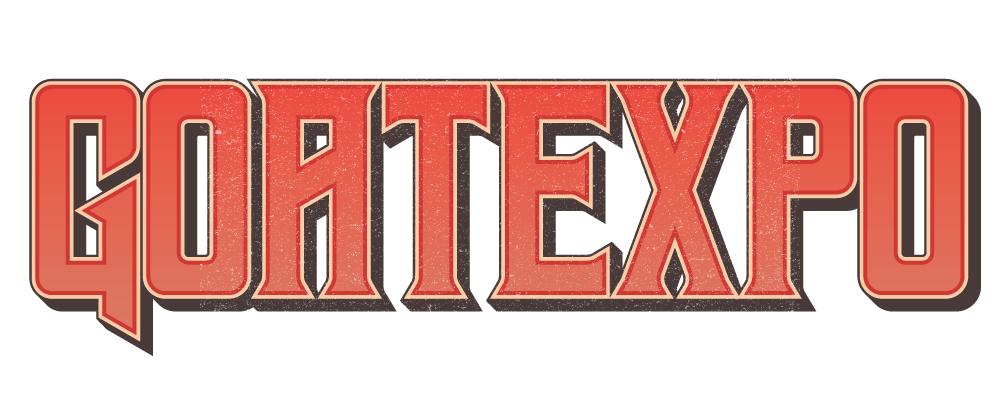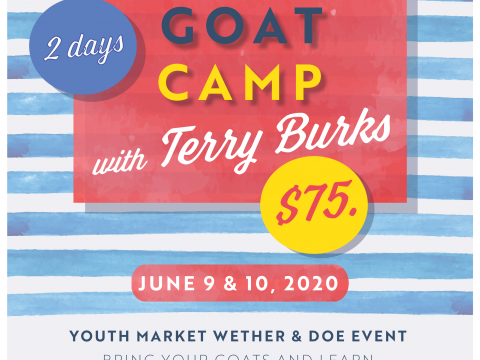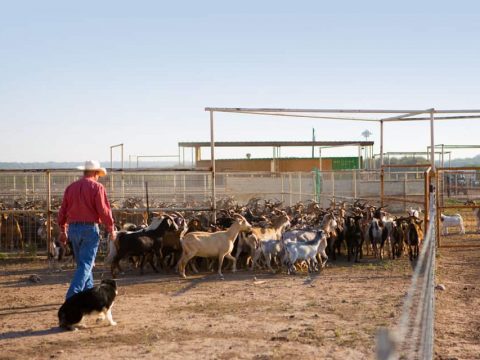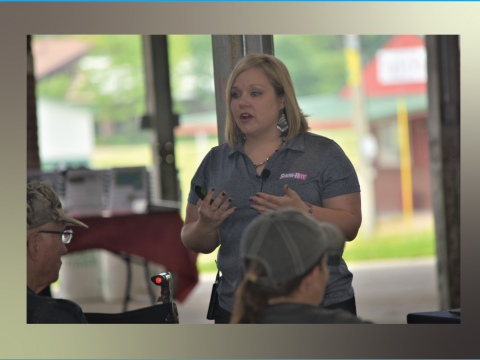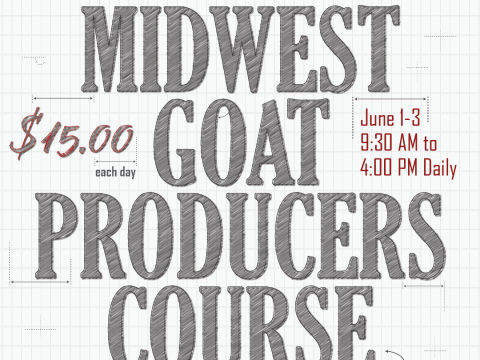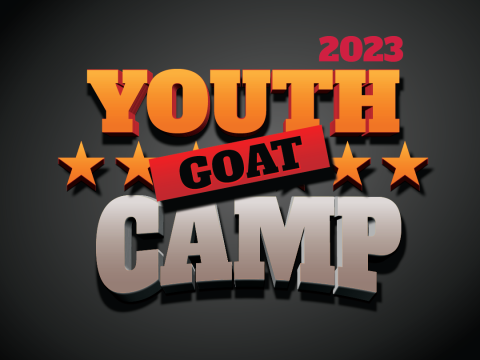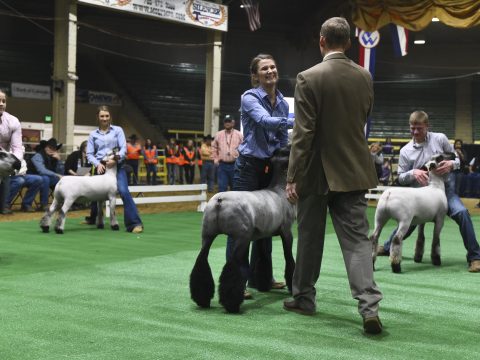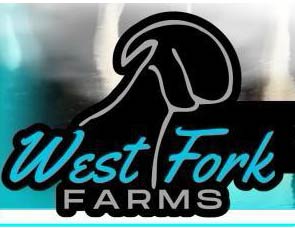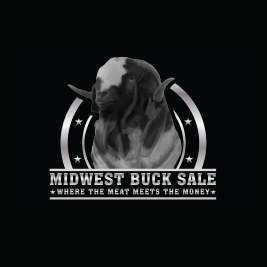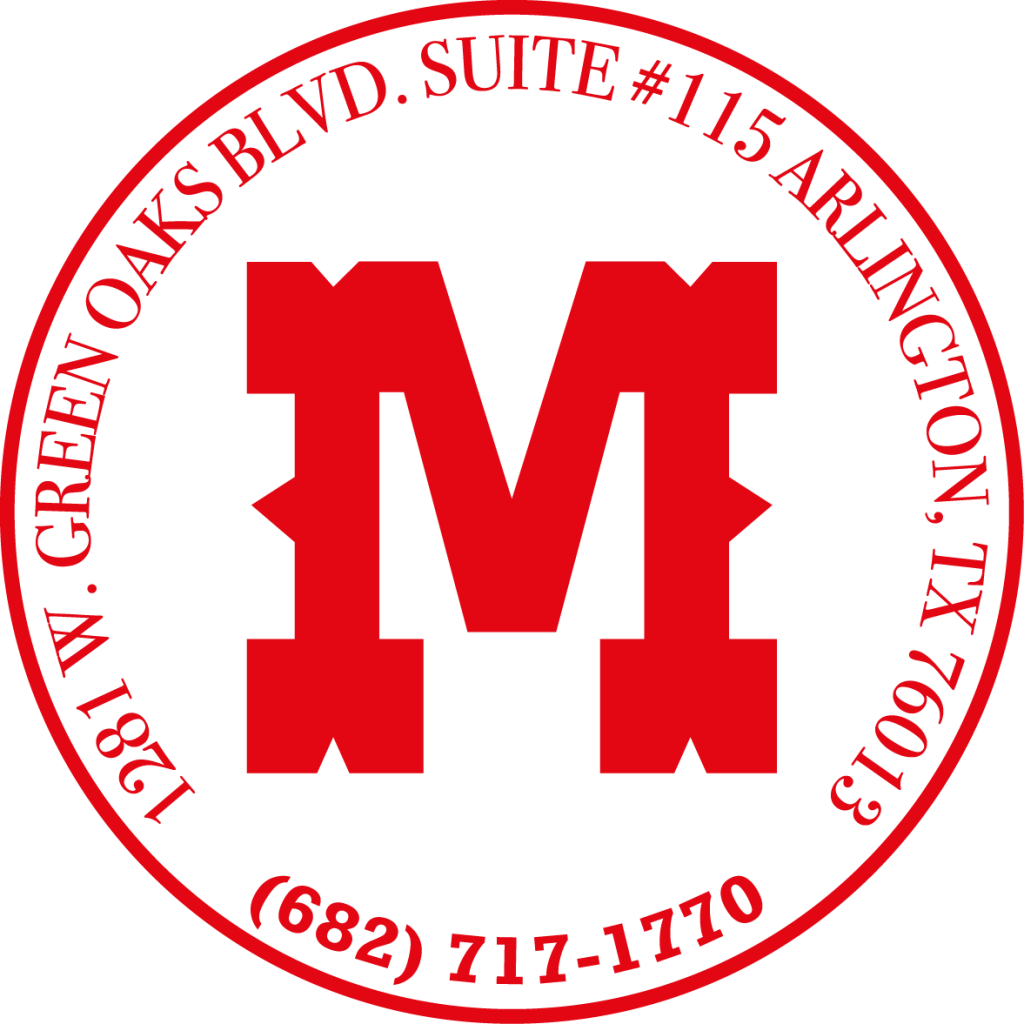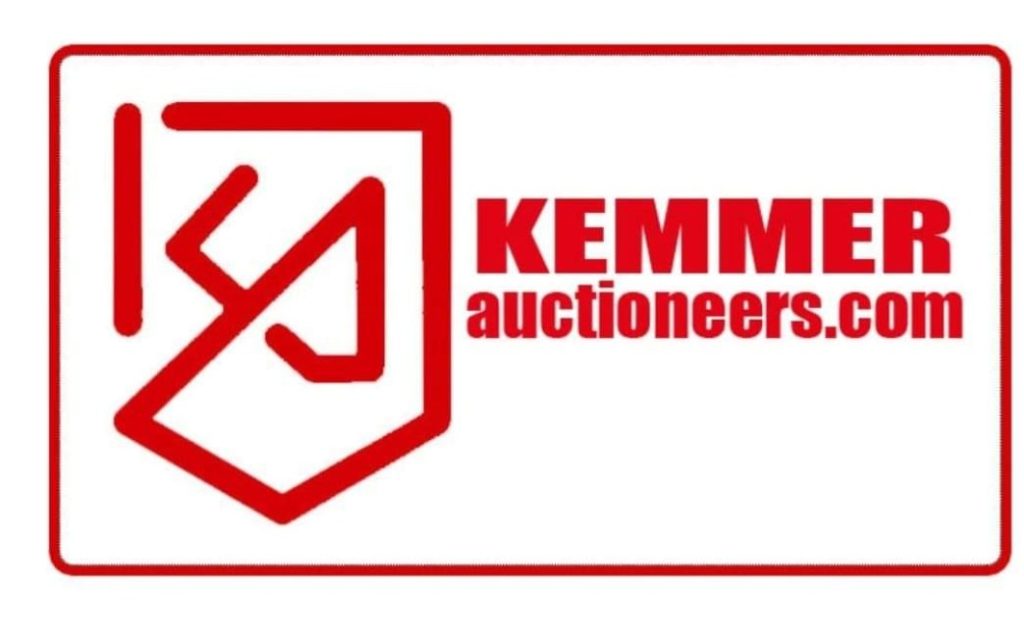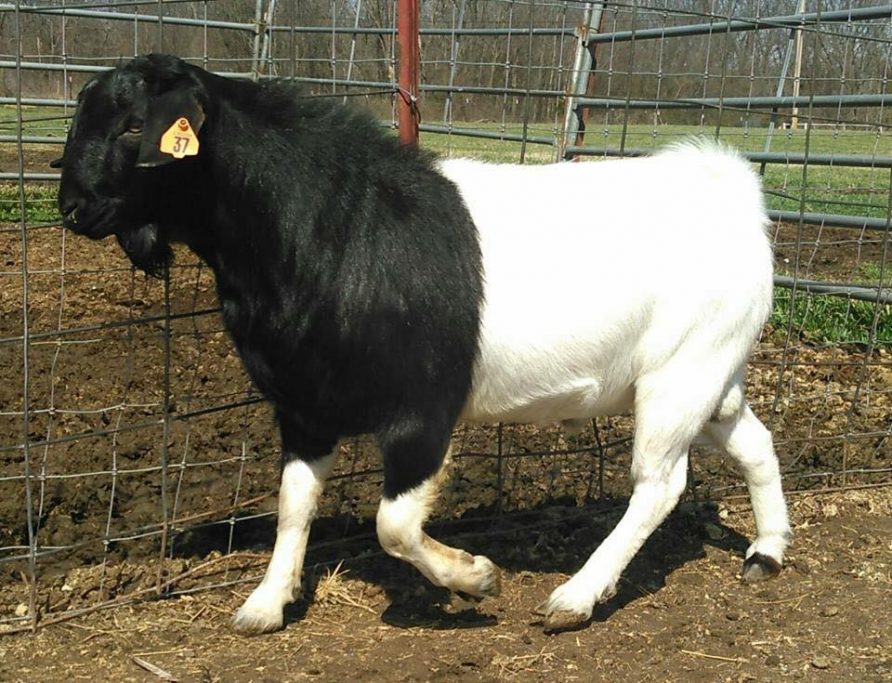
5-6. Feedlots for Meat Goats: Opportunities, Constraints, and Economics
By Frank Pinkerton, Ken McMillin, and An Peischel
Preface
Occasional enquiries come to Editor Hankins and Rancher columnists from producers, and other players in the goat marketing channel, concerning the feasibility of establishing feedlot enterprises for goats; this article is our response. There are articles on related topics in the chapter 2 on Marketing Meat Goats; see Target Marketing of Slaughter Goats, and, in particular, Feeding, Management, and Marketing of Slaughter Goats Post- weaning. Caveat: My co-authors and I feel that commercial feed-lots for goats will likely come to pass only if, and when, consumers could be persuaded to opt for novel offerings of goat meat (primal and retail cuts and processed value-added products) and if traditional season supply patterns could be adjusted by producers to supply near year- round supplies of slaughter goats.
Introduction
In the ‘post-weaning’ article noted above, we said that feeding and management programs for increasing sale weights post-weaning have long been used in cattle, sheep, and swine enterprises for a variety of economically rational reasons, for example, to:
* increase the quantity of edible meat realized from each breeding female; *cater to consumer demand for individual, larger, well-marbled cuts of meat; *lower the cost/lb of slaughtering/processing;
*more closely balance supply with demand across seasons.
We also reminded readers that we currently import nearly half of our national goat meat needs; consequently, there is an obvious opportunity to increase domestic supply of goat meat. To do so, we could:
*enlarge base herd numbers by increasing the number of goat producers and/or increasing herd size/producer;
*increase annual off-take/doe from current and/or increased base herd number via improved management practices (genetics, nutrition, reproduction, health);
*increase edible meat yield/carcass via improved dressing percentage and/or improved muscle-to-bone ratio and/or reduced waste fat;
*increase slaughter weights and thus edible meat/goat
It is the purpose of this article to describe the opportunities for, and constraints to, implementing the last option, namely, increasing slaughter weights.
Strategies for increasing weight of slaughter goats
Typical marketing channels for beef cattle encompass ‘cow-calf’ units producing 3-600 lb weanlings (feeder calves), ‘stocker-calf’ units to grow animals from 300 to 7-800 lb, and, finally, ‘finishing units’ (1,000 to 1400 lb final weights)—commonly called feedlot operations. Weanling lambs sometimes follow a similar flow pattern, but the majority goes directly to finishing (feedlots). However, some lambs do go as weanlings, or shortly thereafter, to slaughter as ‘grass-fat’ (unfinished) lambs (a la New Zealand and Australian imports). Market-ready pigs typically go through a ‘grower’ phase and a ‘finishing’ phase, usually on the farm of origin, sometimes not. More recently, higher volume commercial (corporate) pork production is commonly done in ‘farrow-to-finish’ (integrated) operations at one location.
Contrarily, meat goat kids typically pass through auctions to packers at, or shortly after, weaning at 35-65 lb at 4-9 months of age. Unlike cattle, there are today relatively few ‘stocker-goat’ operations and fewer still feedlot operations in the meat goat industry. This not to say that such operations could not become more prevalent, of course, but such increases will occur only if certain constraints can be economically circumvented.
Constraints to stocker and finishing operations
If a producer raises, or buys, weanling goats to grow to heavier weights on pasture and/or hay and/or small amounts of grain, this is commonly called a ‘stocker-goat’ operation. Such stocker-goats usually go to packers, again via auction. However, such stockers could be sold to a feedlot. Thus, a feedlot operation can obtain its supply of ‘feeders’ from either stocker operations or from farmers/ranchers selling kids post-weaning or from auctions or order-buyers.
A goat feedlot operation may take two forms. For convenience, I use the terms, extensive and intensive, to distinguish between the two. An extensive operation features goats on pastures or on relatively large paddocks with hay available ad lib, plus concentrate (either in self-feeders, or ‘hand-fed’ once or twice daily) while intensive operations feature a more classical feedlot environment…i.e., a relatively small confinement area with actual densities (square feet/head) depending on site and facilities used.
There are a number of constraints to establishing goat feed-lot enterprises; we describe them in approximate descending order.
First, ethnic consumers of goat meat have traditional, serious preferences for two carcass characteristics that militate against commercial feedlot operations…one is a carcass weight limitation of 40 lb (80-85 lb live weight); the second is a strong bias against carcass fat (both external and internal; also note that marbling is not really a goat- consumer concern). The significance of this carcass size limitation is that it limits the amount of weight that a feedlot operation can add to a feeder-goat weighing 35-55 lb. This same limitation occurred in lamb-finishing operations early on, but does not
currently because of the rise in acceptable slaughter weights and, concomitantly, more desirable retail ‘cut sizes’; larger carcasses also lowered labor cost/lb.
Secondly, goats have, historically, been browsers and grazers and thus have not been subjected to genetic selection for high daily gain (ADG) or for feed conversion efficiency (FCE), nor, until lately, have they been exposed to higher energy, grain-based diets. Thus, many, if not most, goats placed in feed-lot environments featuring more costly, relatively high-energy diets fed ad lib do not demonstrate very desirable FCE and, consequently, an undesirable ADG. This being the case, the resulting feed cost/lb of gain is relatively high, and, since ADG is not high, the time on feed is extended, thereby increasing overhead expense. Accordingly, the total cost of a pound of gain in a feedlot situation (either intensive or extensive) is often relatively high.
Thirdly, confinement-type feed-lots necessarily gather goats from multiple sources throughout the year. Such sources undoubtedly reflect widely varying management practices regarding nutrition, health, reproduction, genetics, environment, etc. Recognizing these variations, a prudent feedlot operator will: 1) quarantine incoming groups for a period of intensive observation (7-10 days, or more) during which he will control composition and quantity of diets offered and 2) institute medical procedures to recognize, treat, and protect against various diseases. Co-author Peischel identifies some possible major killers in confinement situations: coccidiosis, listeriosis, trichostrongylus, ‘instant grain bloat’, Clostridium perfringens ‘B’/PEM, and behavioral anomalies.
If these two practices are not done—no matter the expense—the operator and his goats will have a short tenure indeed. Cattlemen call these defensive-management practices ‘preconditioning’ (earlier on: ‘back-grounding’), and they are usually done at the beginning or end of the stocker period or on arrival at the feed-lot.
Fourthly, the demand for goat meat seems fairly steady (but with a number of holiday peaks) across the year, and a goat feedlot would need to stay near full capacity year- round to operate cost-efficiently. Unfortunately, the supply of feeder-goats is nowhere near constant across time. While prospective feeder-kids are born every month, there is a discernible, recurring seasonal pattern to births. Probably 2/3s, perhaps more, of the annual kid crop is born Jan through April with the remainder scattered across the calendar.
The mid-Aug to early-Nov interval sees particularly low birth months because mid-Mar to early-Jun is a period of substantial anestrous (non-cycling) in meat goats, regardless of breed. Moreover, many producers arbitrarily choose to breed in Oct/Nov to better ‘match’ kidding time with warmer weather and the advent of warm-season grasses. Historically, this seasonal birth ‘window’ causes sales prices to move lower in Jul, Aug, Sep, and Oct in response to volumes of weanlings being sold post-weaning. Accordingly, the seasonality of feeder-kid supply is a serious problem for feedlot operations.
Fifthly, the profit margins to be derived from post-weaning feeding programs (stocker and feedlot) tend to be erratic and marginal; see the earlier pieces in this Section for cost- benefit calculations and, secondly, opportunities for improved profit-taking.
Economics of post-weaning programs
The profit per feed-lot goat is the difference between his gross income and all his expenses. Gross income is the net sales-income after deductions for commission/yardage costs. For planning purposes, one has to estimate the shrunk live-weight to be sold and then multiply that figure by the estimated price/lb to be received 90-100 days in the future. Experience has shown that feed-lot goats will shrink about 4% of farm weight during hauling and handling via auction sales…about 3 lb on an 80 lb goat, or 77 lb shrunk-weight across the scale. If the estimated selling price were $1.40/lb, the gross would be $107.80; subtracting, say, 5% auction charges of $5.39 (107.80 x .05) would yield $102.41 as the net sales income/head. Put differently, this is the gross income to the feed-lot operator. (Cost of hauling to the sale would be included in the overhead costs; see below).
Feedlot expenses to be incurred fall into three categories: feeder-kid cost, feed cost, and overhead cost. Again for planning purposes, one must estimate dollars/head to be spent for each of the three categories. If the feeder kid is to be purchased at the auction, its cost can be estimated fairly accurately by attending one or more sales; such prices are also useful for bartering with on-farm sources of feeder kids. An informed prospective buyer would be aware that a producer/seller ‘saves’ commission, shrink, and hauling costs by selling directly to him; thus, price determination is done, as always, by spirited haggling. For illustration, I assume a 40 lb kid at $1.20/lb for a cost of $48/head; hold that figure in your mind.
Feed cost/head depends on quantity of feed eaten and its price/lb. Confinement feeding operations typically use total mixed rations (TMR) containing some combination of roughage, grain, protein supplement, minerals, and perhaps additives. Limited research and on-farm experiences have shown that kids growing at an ADG of .4 lb from 40 to 80 lb require at least 6.5 lb of TMR to put on 1 lb of gain. If so, the 40 lb of gain will require 260 lb of feed (40 x 6.5). If the TMR costs, say, 12 cents/lb, the goat’s feed bill would be $31.20 (260 x .12). Thus, his feed cost/lb of gain would be $.78 (31.20/40); (an alternative calculation is: 6.5 FCE x 12 cents = $.78).
If this kid achieved .4 lb ADG, he would be on-feed 100 days (40 lb gain/.4 ADG). During this time, he would engender certain operational expenses; the sum is called overhead cost. When planning a feedlot venture, one necessarily estimates an overhead figure/head. It must include interest on kid-cost ($48 x 8% = $3.84 x 100/365 = $1.05), non-family labor charge, facilities ‘rental’, health costs, death loss, vehicle use, etc. For this example, I estimate $6/head for the 100 days on fed; for 40 lb gain, this calculates $.15/lb of gain (6.00/40); actual overhead expenses are, of course, always site-specific.
Using the examples above, this slaughter kid had a gross income of $102.41 less expenses of $85.20 (48.00 kid + 31.20 feed + 6.00 overhead) for a profit/head of $17.21. Let us now examine how we really made this profit. Experienced feedlot operators (for any species) know that there are but two ways to make a profit in such businesses.
The first way is the marketing margin/head, calculated thusly:
(Price/lb of slaughter goat – price/lb of the feeder kid) x purchase weight of kid
($1.40 -5% comm. = $1.33 – $1.20 = $.13) x 40 lb = $5.20/hd profit on the increase in
the value of the original kid weight. (Note that the 13 cents is the profit/lb). The second way is the feeding margin/head, calculated thusly:
(Price/lb of slaughter goat – (feed cost/lb of gain + overhead cost/lb gain) x accrued gain ($1.40 – 5% comm. = $1.33 – $.93 ($.78 + $.15) = $.40 x 40 lb = $16.00 (apparent) profit on the accrued gain.
When one adds the profit from the marketing margin ($5.20) to the apparent profit from the feeding margin ($16.00), the total profit/head is $21.20; this figure is not the same as our earlier calculation of $17.21/head. The discrepancy, $3.99, is accounted for by the missing 3 lb of hauling shrinkage that the goat experienced ($1.33 net selling price/lb x 3 = $3.99). Essentially, one pays the cost (feed plus overhead) of this 3 lb of gain which then disappears during hauling. So…we earned $5.20 on the purchase of the feeder kid and actually earned $12.01 on the accrued gain, for a total of $17.21.
Perceptive readers will quickly note that both the marketing margin and the feeding margin could be either positive (profit) or negative (loss) or breakeven (neither gain nor lose) for any given set of goats going through a feed-lot. Yes, indeed, and those that think differently will be promptly and painfully educated.
Consider the marketing margin…lightweight goats (35-45 lb) may well cost more/lb than they will later sell for as heavyweights (70-80 lb); accordingly, the marketing margin will be negative (if so, one would logically wish to buy as lightweight as possible in this scenario).
Regarding the feeding margin, if it estimates positive, one would wish to put on the maximum gain, but, if it estimates negative, one would like to buy heavier goats for a relative short time on feed. In any case, feeding margins are subject to serious gyrations—due to selling price/lb, of course, but also due to poor FCE/ADG and to rising costs of feedstuffs/lb, not to mention rising overhead costs.
If both the marketing margin and the feeding margin are positive on any given batch, it will be profitable, by some measure. If both margins are negative on a given batch, it will lose money—a little or a lot. If the marketing margin is slightly negative and the feeding margin is slightly positive, the batch may lose or gain a bit, or break-even. The opposite condition (slight positive marketing margin and slight negative feeding margin) can lead
to similar results. Caveat: one margin simply has to be more profitable than the loss sustained by the other margin; otherwise one can not survive (for long). No rocket science here, for sure.
Opportunities for profitable feedlot operations
We have demonstrated that a profitable marketing margin occurs only when the cost/lb of the feeder-kid is less than his selling price/lb at slaughter. The recurring summer slump in prices for weanlings offers some opportunity for ‘buying low’ and ‘selling high’ into the winter slaughter market (if one does not exceed the 80 lb figure and decline in selling price/lb).
An astute buyer would try to select smaller goats and those that would grade only #2 or #3 (but be thin-but-thrifty types, just ‘short-of-feed’, not unhealthy; which, with feeding, most could likely be up-graded to # 1 or high #2 (higher price/lb). In the southern states (including TX), such animals are frequently available at local auctions and, less frequently, from farms or ranches.
There is, of course, a sort of ‘scheduling problem’ in this scenario in that the feeder-kids should be purchased in Aug/Sep to be fed for 90-100 days and then sold Thanksgiving to Christmas as slaughter prices rise. This is not to say that Jun/Jul kids could not be bought, carried on pasture (with minimum supplementation) for cheaper, slower gains until Nov or so (basically a stocker operation which some producers do with their own goats, plus purchased goats if they so elect).
Unfortunately, feedlot operators would have difficulties finding sufficient 90-120 day ‘buy-sell’ windows permitting relatively cheap prices for feeders and offering higher prices for their slaughter goats; given this situation, their lots may be semi-vacant at least some of the time. Most certainly they can not buy feeder-kids during thee four month winter-highs in prices, feed them for 3 months or so, and sell into the four month period of low summer prices because the negative marketing margins could well exceed any positive feeding margin and thus incur a substantial loss.
To be realistic, managing a post-weaning gain program (particularly an intensive feedlot) is an exercise in gambling; do not think it otherwise. Dedicated capitalists might find it challenging, exhilarating, and possibly, or even usually, profitable. Contrarily, the timid (like me) might prefer the glitter and comforts of Las Vegas or Reno—at least they could eat/drink well and ogle semi-naked women or handsome young men while they were dispersing their venture capital at the tables….
Concluding cautionary comments
Long experience in lamb feedlot operations finds that the profit margins/head are, on the average, rather modest ($5-17). Even so, there are some (usually large-volume) operations that are economically sustainable; most have on-going contractual relationships with packers who distribute wholesale and retail cuts to supermarkets, food
distributors, etc. Insofar as I know, there are presently no equivalent-scale goat feedlots in operation. There are, however, a number of smaller goat operations in certain areas that buy/feed/sell in a sort of continuous cycle designed in part to have slaughter goats available at peak holiday demands.
FYI, if, say, $15/head profit on a feedlot goat could be achieved (on the average) for three batches per year, and if the one-time capacity of the lot were, say, 2,000 goats, the income to labor, management, and capital would be $90,000/year. Such a figure might or might not be thought ‘good’; much would depend on return-on-investment levels achieved.
In any case, there is here a strong caveat to be observed. Under current federal law, a lamb feedlot with a one-time capacity of 3,000 head, or more, has to meet rather stringent rules and regulations—for establishment, and for operation. I assume the same would true for a goat feedlot should it be planned and implemented. My co-authors have identified certain procedures and sources of information (websites) concerning these issues for your possible review. Dr. McMillin suggests:
http://www.epa.gov/agriculture/factsheets/epa-305-f-03-009ag.html
http://www.csrees.usda.gov/nea/ag_systems/in_focus/manure_if_factsheets.html
http://www.extension.org/pages/LPES_Curriculum_CAFO_Fact_Sheets
http://text.lsuagcenter.com/en/crops/livestock/livestock/poultry/Environmental+Concerns /Environmental+Issues+F
Dr. Peischel states that:
CAFO (Concentrated Animal Feeding Operations) regulations must be observed, and one must get an initial permit from EPA. Moreover, one must ‘pass’ the Clean Water Act regulations and also get obtain the Outline of Cattle Welfare Critical Control Points on Feedlots, Ranches and Stocker Operations and make sure all points are being practiced during lot operations. On must also follow the American Association of Bovine Practitioners guidelines for euthanizing unhealthy animals.
She also cautions that if a producer sends goats into a feedlot operation with his NAIS ID number on them, and if a health issue develops, there will trace-back recriminations and possible legal difficulties in the offing. An suggests this situation should be fully assessed prior to final decision-making; Ken and I heartily concur.
In conclusion, we feel that one would have to be a very astute business entrepreneur to succeed in a large goat feedlot venture. If one is not a risk-taker, and one with sufficient resources to bear the losses that inevitably occur in some years due to negative marketing and/or marketing margins, one should simply not go gambling.
Addendum
I asked long-term friend, Dr. Bob Herr of Narvon, PA, to review this piece and offer constructive criticism. As an experienced goat-raiser, broker-buyer of slaughter goats, and ‘small’ feedlot operator with extensive marketing experience at the nearby New Holland Sale Barn, he is uniquely qualified to make the useful observations which I now share, as paraphrased.
As long as producers continue to raise kids on grass and market less-than-finished animals, there will be some opportunity to ‘feed-lot’ goats, possibly at a profit, to supply niche demand by northeastern Latino and Kenyan consumers, and possibly others, who want extra finish, even fat, goats. However, I concede that, because of the demand for even poorly-conditioned young goats, such animals likely will sell for more than a feedlot operator could afford to pay for them. (FP: behold, the specter of the negative marketing margin earlier described).
Currently, a goat feedlot operator would need to find stocker goats at affordable costs and appropriate ages to target significant holiday periods when goats of higher finish are on demand. My thought is that such operators should (can) not try to operate year-round— most certainly not until there is more sustainable consumer demand at supermarkets. But, perhaps smaller feedlots utilizing different ‘stockers’ is one answer for prospective operators. For example, they might select older, thinner nannies which have just weaned kids; such animal typically sell at quite low prices at auction. Many are relatively healthy, require lower-protein (cheaper) diets, have the body capacity for high roughage intake, and are physiologically able to make rather rapid, economical gains. (FP: this describes the phenomenen of ‘compensatory gain’ in goats; cattlemen have long capitalized on improved FCE and high ADG using thin-but-thrifty bulls and cows). This niche feeding and management program could enable an operator to simultaneously realize positive (profitable) marketing and feeding margins.
A second example of a niche feeding and management could occur if an operator had access to supplies of early-weaned kids (usually from extenuating circumstances such as drought or other forced sales). Again, buying prices can be relatively low and, assuming a proper health-care program, the marketing margin could very likely be positive. The feeding margin could also be positive (due in part to better FCE demonstrated by younger goats as compared to older, heavier goats). If so, happiness is possible, if not assured.
A concluding comment, Frank…NAIS ID numbers are purposefully designed to permit trace-back procedures to specifically locate/identify animal health problems. Producers may/may not approve of this program, but packers, supermarkets, and other retailers are active proponents of such ‘defensive’ measures because it is in their economic interests to be able to ‘assure’ consumers that all is well—or will quickly be—and sales are not seriously interrupted (much less compromised for the future). USG Agencies are, of course, legally bound to protect consumer’s meat, and other, food supplies. Feedlot operators, large or small, are or will likely be participants, willingly or not; all will necessarily live with it—or not?
Shared with permission by Dr. Frank Pinkerton.
Dr. Pinkerton will be our speaker June 2, 1:00 pm and our official for the round table discussion that day at 4:00 pm. We will also be celebrating his 93rd birthday. Come and meet a man that is a wealth of information for the meat goat industry. See you there. Sign up for the FREE SPEAKERS< CLICK HERE

